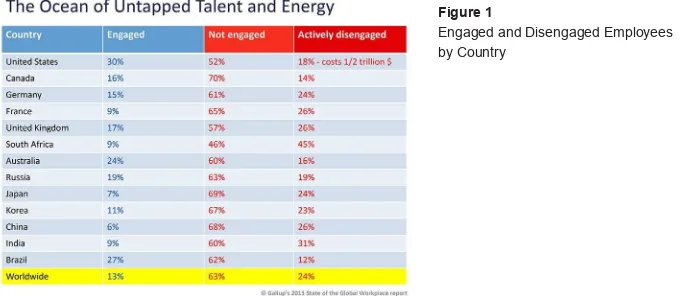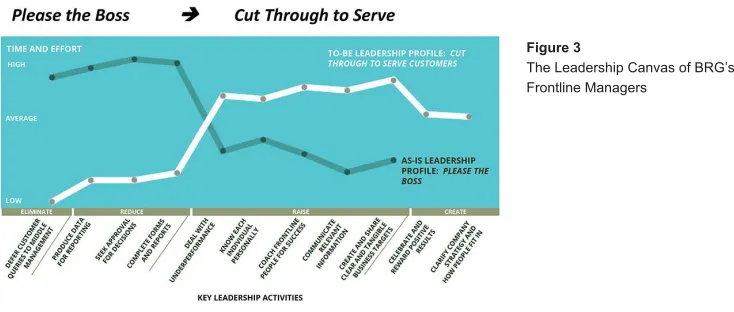From Blue Ocean Strategy to
Blue Ocean Leadership
A HARVARD BUSINESS REVIEW WEBINAR FEATURING
Renée Mauborgne
juLy 15, 2014
OVERVIEW
Blue Ocean Strategy provides companies a new way of thinking about where and how to
compete to drive proitable growth. Blue Ocean Leadership uses many of the same principles
and analytic frameworks to help companies engage previously disengaged people by
chang-ing the company’s leadership proile. It produces a leap in leadership strength quickly and at low cost.
Blue Ocean Leadership focuses on leaders’ acts and activities; not their behaviors, traits, or values. A helpful analytic tool involves assessing the organization’s “as is” leadership pro
-ile, and after considering multiple possibilities, determining the “to be” state. Blue Ocean Leadership helps leaders tap into the huge untapped ocean of talent and energy within the organization, producing both qualitative beneits (greater alignment, increased motivation, more energy, and a talent pull) as well as qualitative beneits (lower turnover and recruiting costs, increased satisfaction, and stronger inancial performance).
CONTEXT
Professor Renée Mauborgne summarized the basic ideas from Blue Ocean Strategy, explained how these apply to leadership, and shared a simple analytic framework that organizations can use to improve leadership and irm performance.
KEY LEARNINGS
Blue Ocean Strategies help companies drive proitable growth.
Published in 2005, Blue Ocean Strategy is an international best seller which has sold more
than 3.5 million copies and brought to life new ideas that have helped companies improve their performance and transform themselves.
Companies in all industries increasingly compete in hotly contested, commoditized, bloody “red oceans.” Blue Ocean Strategy provides a new way of thinking. The idea is to create uncon
-tested new market spaces (“blue oceans”) where the competition is irrelevant. In blue oceans, companies invent and capture entirely new demand. Professor Mauborgne summarized three key principles underlying Blue Ocean Strategies. These are strategies that:
• Open an ocean of new market space by pursuing both differentiation and low cost. They are strategies of AND; not of either/or.
• Create new demand by converting non-customers of an industry into customers.
• Offer systematic, reproducible, and visual tools and processes for the effective formulation
CONTRIBUTORS
Renée MauborgneProfessor of Strategy and Manage-ment, INSEAD; Co-author of Blue Ocean Strategy and “Blue Ocean Leadership”
july 15, 2014
From Blue Ocean Strategy to Blue Ocean Leadership
“The challenges
companies face is
that they want to
implement Blue
Ocean Strategy but
they first need to
address leadership.”
– Renée MauboRgne
Strategy and leadership are inseparable realities.Extensive experience with companies that have attempted to execute Blue Ocean Strategies has shown that strategy and leadership are inextricably linked. Many companies that have wanted
to implement innovative new strategies have felt that without a step change in their leadership
capabilities, they were not equipped to move forward with a new strategy. Thus, lack of leader
-ship strength prevents companies from devising and executing strategy.
The number one leadership issue that companies face is disengaged employees. Data from Gallup shows that in every industrialized country the vast majority of employees (at least 70%) are disengaged, and many are actively disengaged. This represents a huge ocean of untapped talent and energy.
Figure 1
Engaged and Disengaged Employees by Country
Lack of employee engagement can be thought of as a leadership issue. Leadership in essence is a service that people buy or don’t buy. In this sense, leaders have customers, but disengaged employees who don’t buy into leadership are non-customers.
Seeing disengagement as non-customers choosing not to buy what leaders are trying to sell
caused Professor Mauborgne and co-author W. Chan Kim to see analogies in the strategy chal
-lenges companies often face and the leadership chal-lenges they confront. This led Mauborgne and Kim to develop Blue Ocean Leadership, adopting elements and analytic frameworks from their work on strategy to address leadership.
Blue Ocean Leadership applies concepts from Blue Ocean Strategy to develop an organization’s leadership capabilities.
The concepts of Blue Ocean Leadership differ from traditional leadership models in that Blue Ocean Leadership:
1. Focuses on acts and activities. Most leadership efforts focus on cognitive and
behav-ioral skills, such as empathy, self-awareness, and self-regulation. But it is extremely dificult and slow to transform behaviors of large numbers of individuals. The reasons for focusing on acts and activities are because acts are easy to specify what to do or not do; it is easier to change what you do than who you are; acts are measurable; and acts and activities are linked to performance.
2. Connects to an organization’s market and business realities. Blue Ocean Leader
-ship is not generic; it is speciic to each organization’s speciic situation.
3. Emphasizes distributive leadership. The ideas of Blue Ocean Leadership apply not
just to senior leaders but to all levels of leaders in an organization.
Blue Ocean Leadership is achieved through a four-step process. Here is how organizations can go about achieving Blue Ocean Leadership:
1. Assess the organization’s current leadership reality (the “as is” state). This can
be done by assembling a small group of senior leaders (10–15) and using The Blue Ocean Leadership Grid. Leaders should ask others in the organization how they are experiencing leadership, and what acts and activities leaders should eliminate, reduce, raise, and create. This process provides a common language for talking about leadership and a roadmap.
Figure 2
From “As-Is” to “To-Be”: The Blue Ocean Leadership Grid
2. Develop alternative leadership proiles. After the current leadership reality is under
-stood, organizations then assemble teams that develop multiple possible leadership proiles. 3. Select the leadership proile that will best unlock disengaged employees. A good
july 15, 2014
From Blue Ocean Strategy to Blue Ocean Leadership
Organizations can develop a leadership canvas for each level of leadership. For example, a British retailer’s as-is proile showed that front-line managers are focused on pleasing the boss. The desired “to be” state is to cut through bureaucracy to serve customers.
Figure 3
The Leadership Canvas of BRG’s Frontline Managers
4. Institutionalize and execute the new leadership model. Once the desired new
leadership state is deined, the key is to institutionalize it throughout the organization. This involves explaining it to subordinates, developing measures, and holding monthly meetings to assess progress. Often organizations focus on attracting the best talent. Blue Ocean Lead
-ership focuses on engaging the ocean of talent that already exists within organizations.
The beneits of Blue Ocean Leadership can be signiicant.
The beneits are both quantitative and qualitative. Quantitatively, companies that engage employees decrease turnover and absenteeism, decrease recruitment and training costs, increase customer satisfaction, and improve inancial performance. Qualitatively, beneits include leadership and market alignment, a sense of freedom and ability to perform, boosted motivation with excitement and positive word of mouth among employees, talent pull, less stress, and more energy.
“There is a great deal of
talk about the war for
talent. More important
is unlocking the huge
ocean of untapped
talent that already
exists.”
BIOGRAPHIES
Renée Mauborgne
Professor of Strategy and
Man-agement, INSEAD; Co-author
of Blue Ocean Strategy
Renée Mauborgne is The INSEAD Distin
-guished Fellow and a professor of strategy at INSEAD, the world’s second largest business school. She is also Co-Director of the INSEAD Blue Ocean Strategy Institute.
Mauborgne is a member of President
Barack Obama’s Board of Advisors on
Historically Black Colleges and
Universi-ties (HBCUs). She is also a Fellow of the World Economic Forum.
Mauborgne has published numerous
articles on strategy and management. She
is the co-author of Blue Ocean Strategy: How to Create Uncontested Market Space and Make the Competition Irrel-evant (Harvard Business School Press, 2005). Blue Ocean Strategy has sold over
3.5 million copies and is being published in a record-breaking 43 languages. It is a bestseller across ive continents and has won numerous awards.
Mauborgne ranked No. 2 in The Think
-ers50 listing of the World’s Top Manage
-ment Gurus, in 2011 and 2013. She is the highest placed woman ever on Think
-ers50. In 2014, Mauborgne, along with her colleague W. Chan Kim, received the Carl S. Sloane Award for Excellence from the Association of Management Consult
-ing Firms. She also won the 2011 Think
-ers50 Strategy Award. Mauborgne was selected for the 2011 Leadership Hall of Fame by Fast Company magazine and as
one of the World’s 50 Best Business
School Professors in 2012 by Fortune. com. She was also named among the world’s top ive best business school pro
-fessors in 2013 by MBA Rankings. Mauborgne received the Nobel Colloquia Prize for Leadership on Business and Eco
-nomic Thinking 2008 and is the winner of the Eldridge Haynes Prize for the best original paper in the ield of international business. She is the winner of the Prix DCF 2009 in the category of “Straté
-gie d’entreprise.” L’Expansion named
Mauborgne along with her colleague W. Chan Kim as “the number one gurus of the future.” The Sunday Times (London) called them “two of Europe’s brightest business thinkers.” The Observer called
Kim and Mauborgne, “the next big gurus to hit the business world.” She won the 2007 Asia Brand Leadership Award.
Mauborgne is the winner of several Case
Centre awards.
Mauborgne co-founded the Blue Ocean
Strategy Network (BOSN), a global com -munity of practice on the blue ocean
strat-egy family of concepts that they created. BOSN embraces academics, consultants, executives, and government oficers.
Melinda Merino (Moderator)
Senior Editor, Harvard Business Review
Melinda Merino is Senior Editor at Har-vard Business Review where she leads
acquisitions in the areas of strategy, inno
-vation, talent management, and emerging markets. She has published a number of
HBR Press best-selling books including Blue Ocean Strategy by Chan Kim and Renee Mauborgne, Michael Porter’s On Competition, and Conscious Capitalism by John Mackey and Raj Sisodia. Melinda
has also published several popular HBR articles including an interview with Ram
Charan on executive decision-making and Competing on Talent Analytics by Tom Davenport, Jeanne Harris, and Jeremy Shapiro. Prior to joining HBR Press in 2000, Melinda launched a business publishing program at Stanford-afiliated Consulting Psychologists Press in Palo Alto
and has held editorial and sales positions

